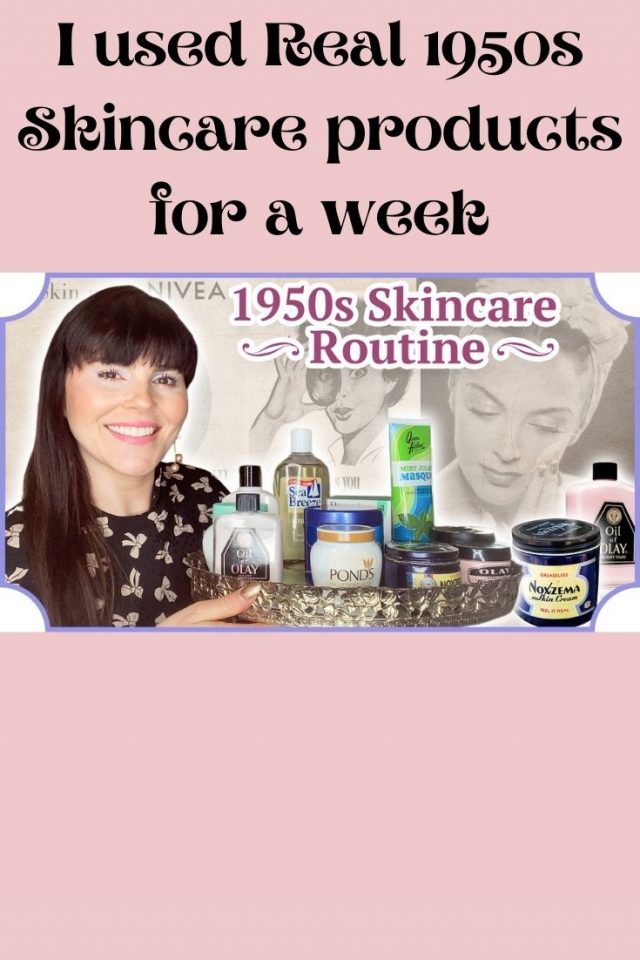
This Post was Sponsored by VIVAIA
Use the Promo code
20% Code: LJA
Hello lovelies, since I have quite the collection of vintage skincare products, I thought it would be fun only to use 1950s skincare products for a week.

In the morning, use Noxema as a cleanser.
Unilever sells the Noxzema brand of skin cleanser. It has been offered in a tiny cobalt blue jar since 1914. Camphor, menthol, phenol, and eucalyptus are among the components in Noxzema. It was originally created to treat sunburns, but it is now widely used as a facial cleanser and make-up remover. It can also be applied on chapped, sunburned, or otherwise irritated skin to provide relief.
Ponds Cold Cream is a nighttime skincare product by Ponds.
Pond’s Cream was developed as a patent medicine in the United States in 1846 by pharmacist Theron T. Pond (1800–1852) of Utica, New York. Mr. Pond discovered that witch hazel [Hamamelis spp.] could be used to make a therapeutic tea that might treat tiny cuts and other diseases. “Golden Treasure” was the product’s name. It became known as “Pond’s Extract” after Theron died.
By the twentieth century, the company’s primary focus had shifted to selling cosmetics. Pond’s products made their debut in the facial care sector with the creation of “Pond’s Vanishing Cream” and “Pond’s Cold Cream.”
Kleenex:
Kleenex was founded during World War I. It created a crepe paper that may be used as a gas mask filter. It was adopted as a consumer product called Kotex brand to help ladies with their periods in the early 1920s. The words “cotton” and “texture” were combined to create the Kotex trademark. This name was chosen because it “matched [their] standards for being short, easy to say, easy to remember, and easy to explain,” according to the corporation. Kleenex was chosen as the name for a line of cold cream remover in 1924, and the “Kleen” element of the name reflects the cleansing purpose of the product. The “ex” was added to indicate that Kleenex was part of the same product family as Kotex. In 1924, the first Western facial tissue was created, and it was marketed as a technique to remove cold cream (it had already been in use in Japan for centuries; see History of facial tissue for details). It was a one-time use alternative to face towels or cotton wool. The first Kleenex tissue advertisement appeared in periodicals in 1925, depicting “the new secret of retaining a beautiful skin as utilised by famous movie stars.” The company’s head researcher sought to persuade the head of advertising to try to advertise Kleenex for colds and hay fever a few years after its inception. The concept was rejected, but the administrator set aside a small quantity of ad space to mention the use of Kleenex tissue as a handkerchief. Kleenex was advertised with the tagline “Don’t Carry a Cold in Your Pocket” during the 1930s, and its use as a disposable handkerchief replacement became commonplace. Kleenex started licencing the Little Lulu cartoon character in 1943 in order to advertise the brand.
Soap with Pears: Double Cleanse
Andrew Pears started making and selling Pears transparent soap in a workshop just off Oxford Street in London, England, in 1807. It was the world’s first translucent soap for mass consumption. A. & F. Pears pioneered a number of sales and marketing improvements under the leadership of Thomas J. Barratt.
Sea Breeze Toner Astrigent
Sea Breeze is a skin care cosmetic brand that was founded in 1906. The original formula was designed to treat minor cuts and scrapes as an antiseptic.
Olay:
Olay’s origins can be traced back to South Africa, where it was first known as Oil of Olay. It was founded in 1952 by Graham Wulff. He came up with the name “Oil of Olay” as a play on the term “lanolin,” which is one of the major ingredients.
It was special in the early days since it came in a hefty glass bottle and was a pink fluid rather than a cream. Wulff and his marketing partner, former copywriter Jack Lowe, had put the product through its paces with their wives and friends and were confident in its distinctiveness and quality.
Olay’s marketing was particularly noteworthy in that it was never referred to as a moisturiser or even a beauty fluid. The product’s exact function was not stated anywhere on the box. Print ads featured content like “Share the secret of a younger looking you” and discussed Oil of Olay’s “beauty secret.”
Nivea
Paul Carl Beiersdorf launched the company on March 28, 1882. It was sold to Oscar Troplowitz in 1890. Troplowitz developed a new skin care cream with the help of Beiersdorf’s partner, Dr Paul Gerson Unna, and German scientist Isaac Lifschütz. Eucerit, the first stable water-in-oil emulsion, was invented by Lifschütz in 1900. Eucerin had its start in this way. Nivea is derived from the Latin adjectives niveus, nivea, and niveum, all of which mean “snow-white.”
Beiersdorf made a variety of items in the 1930s, including tanning oils, shaving creams, shampoo, facial cleanser, and toners. The trademark “NIVEA” was expropriated in various nations during World War II. Beiersdorf repurchased the rights after the war. The NIVEA brand developed into a larger global market during the 1980s.
Queen Heleen debuted in the 1930s.





